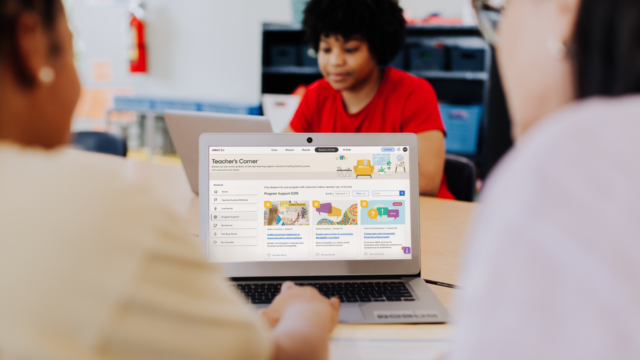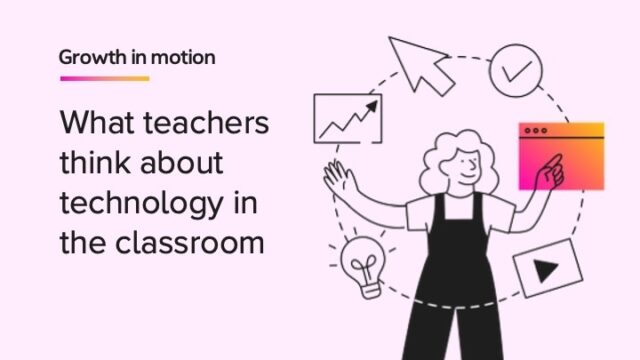
Educators strive to help each student reach their full potential. According to research into mindset that dates back to the early twentieth century and continues to today with the work of Carol Dweck and others, having a more growth mindset can lead to better academic outcomes.
Students aren’t naturally bad at biology, for example, they just haven’t learned it yet. Mistakes aren’t markers of inability; they are opportunities to learn something new or develop critical thinking skills.
So, if this line of thinking helps expand the potential of students, how can teachers foster a growth mindset in the classroom? Let’s take a look at how teachers can reframe how we view intelligence and what it can mean for students.
What is growth mindset in the classroom?
A growth mindset in education is a belief that intelligence and ability can be developed over time. Neither is a predetermined marker for success in life because both can be improved if someone dedicates themselves to the challenge of learning.
Why is growth mindset important in the classroom?
Students who are given the chance to cultivate a growth mindset are more likely to pursue challenging opportunities while developing stronger resilience and critical thinking skills. To them, difficulties experienced in a task are expected. Setbacks are opportunities to learn a new way of doing something.
With a growth mindset, students aren’t afraid to make the occasional stumble. They challenge themselves because they’re interested in pushing their own boundaries. They don’t limit themselves to easier, safer roles that will reinforce their own sense of accomplishment.
Tips for promoting a classroom growth mindset
Avoid simply praising intelligence
Try to avoid telling students phrases like:
- “You’re so smart.”
- “You’re really good at math.”
Although these statements are of course complimentary, they reinforce the idea that students did well on something because of a natural giftedness rather than because they took the time to learn. Praise like this removes the emphasis from growing and places it instead on inherent talents. In doing so, it strengthens the idea that success is a matter of having vs. not having skills when it’s really a matter of building them over time.
It also creates a relationship between results and intelligence. Students who believe that their intelligence is tied to their success might be less likely to take on difficult problems that could possibly make them look flawed or unskilled.
Praise the effort, not the outcome
Focus on the work that went into a task, not just the result. In particular, praise the challenges that a student overcame when solving a problem, and look for examples of working through difficult issues that came up in the pursuit of a solution.
Sample classroom growth mindset phrases:
- “I saw that the problem was giving you trouble at first. Why don’t you tell me about how you figured it out?”
- “You did a great job of trying different methods until you found the one that worked!”
Shifting the focus to the process will reinforce the idea that important growth and development can happen when someone encounters challenges. The result is often important too, but its significance lies in it being a reflection of hard work. Those results come when students continue to push through an issue or use critical thinking to overcome it.
Treat the brain like it’s a muscle
The brain is not literally a muscle (as it’s part of the nervous system, not the muscular system), but it can be helpful to think about working the brain in the same way people build muscles at the gym.
Don’t simply tell a class that they now have to start thinking in a totally new way. Instead, use the muscle analogy to motivate students to train their brains in a similar way. For younger students, a teacher can highlight how students can help their brains grow by learning new things. Portray challenges, frustrations, and other difficult parts of learning as important steps in developing the brain. Just like other muscles that grow through exercise, a brain grows through mental activities.
For older students, a teacher can even share the research on brain plasticity, neural pathways, and how learning builds the brain. Invite them to become active participants and provide resources like those available in the guide to brain architecture provided by Harvard University’s Center on the Developing Child.
Embrace mistakes and their solutions
Normalize struggles and mistakes by talking about them. Treat them as natural parts of the learning process. Avoid positioning mistakes as examples of weakness; rather, present them as moments when a student learned a new way to do something. For example, after a project, have each student discuss the harder parts of the experience. Ask them to share a mistake that they made and how they eventually found a solution to the mistake.
Make it clear that the process of learning gives a positive sense of purpose to mistakes, struggles, and other challenges. Help students understand that these normal experiences don’t reflect poorly on their intelligence. Difficult moments are followed by learning and growth.
Teach the benefits of constructive criticism (and what to do with it)
Constructive criticism, or giving feedback aimed at helping someone else make a positive change, is a necessary component of learning, but not all students know how to receive this feedback. Even fewer know how to effectively channel it into growth opportunities.
Teachers can help students develop a growth mindset by helping them understand the benefits of constructive criticism and how to use it. Explain that constructive criticism doesn’t reflect badly on a student. Receiving it doesn’t mean that the person is incapable.
Instead, constructive criticism is delivered because the student has the potential to do even better. It comes from a place of goodwill when someone else wants to help that student continue to improve. By removing the idea that criticism means a student is unintelligent, a teacher can help their students view it in a less personally critical way and approach it with the goal of continuing to learn.
Set goals
While a student’s belief that they can do something does improve their performance, setting goals is another important component of that growth.
Creating incremental goals helps a student understand and break down complex, overwhelming, or seemingly unattainable results.
This is especially important when setting students up for success on bigger challenges. A smaller part of the larger task might be difficult, but breaking that challenge down into goals removes the sense that the entire task itself is impossible. Students are better equipped to focus on the immediate challenge without feeling paralyzed over the entire activity.
Use the word “yet”
Adding a simple “yet” to phrases can entirely reframe a student’s perspective on themselves. For example, if students say, “I can’t do geometry,” encourage them to say: “I can’t do geometry yet.”
This small qualifier emphasizes the concept of being able to learn something over time. Results won’t be instantaneous, but hard work will eventually contribute to those results. Students’ ability today doesn’t determine their potential for tomorrow.
Be the example
A teacher can foster a growth mindset with their students by setting the example in their own work. Be open about mistakes made when teaching and invite a discussion from students on different solutions available.
Show the class that teachers are just like their students when it comes to learning. They make mistakes, feel frustrated over difficult problems, and stumble when learning something new. Above all, they value the opportunity to overcome obstacles in order to grow.
Teaching growth mindset in the classroom
Research supports the benefits of implementing a growth mindset in the classroom. Doing so results in more motivated students, improves academic outcomes, and helps students understand their own possibilities for growth.
Hopefully, the tools discussed here can help teachers and educators who want to bring this important mentality to their classrooms.
This article was adapted from a blog post initially developed by the education technology company Classcraft, which was acquired by HMH in 2023. The views expressed in this article are those of the author and do not necessarily represent those of HMH.
***
Find more lesson plans and classroom resources on Shaped.
Be the first to read the latest from Shaped.














